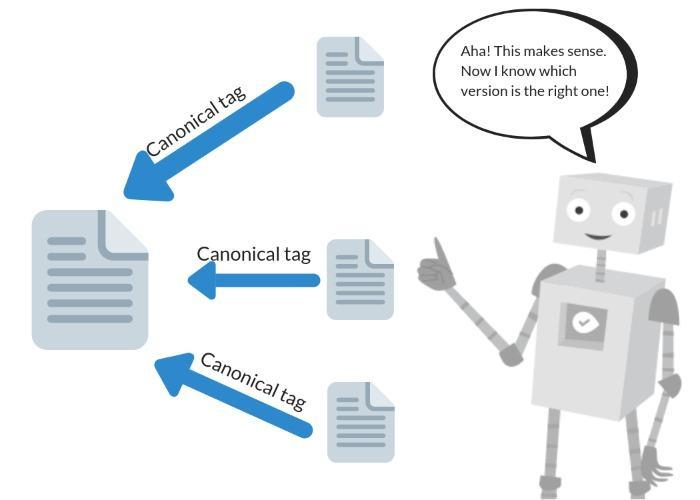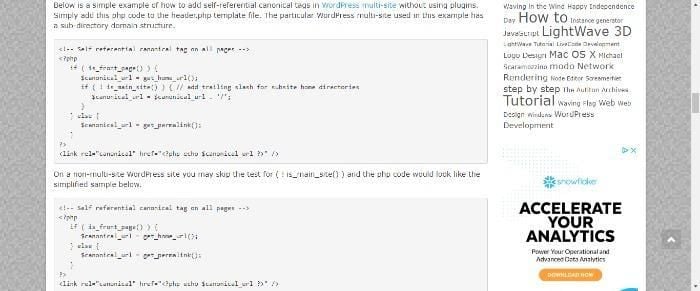In the world of search engine optimization (SEO), technical elements play a crucial role in ensuring your website ranks well and provides a positive user experience. One such technical element is the canonical tag.
While it might sound complex, understanding and correctly implementing canonical tags can significantly improve your site’s SEO performance.
In this blog, we’ll dive into what canonical tags are, how they work, and why they’re important for your SEO strategy.
What Are Canonical Tags?

Canonical tags, also known as “rel=canonical,” are snippets of HTML code that let search engines know which version of a page you consider the original. They are particularly useful for websites with multiple versions of similar or duplicate content.
For instance, if you run an e-commerce store with product pages accessible through different URLs or parameters, you can use canonical tags to specify the preferred URL. This prevents confusion for search engines and ensures the desired page is indexed.
Why Are They Important for SEO?
Duplicate content, whether intentional or unintentional, can create confusion for search engines. Without clear instructions, search engines might:
- Index the wrong page.
- Split the ranking power among multiple versions of the same page.
- Lower your website’s SEO performance.
Canonical tags solve these issues by consolidating ranking signals and directing search engines to the primary page, ensuring consistency in search engine results pages (SERPs).
What is Duplicate Content
What Is Duplicate Content?
Duplicate content refers to substantial blocks of content that are identical or highly similar across multiple web pages. This can happen within the same domain or across different domains.
Google defines duplicate content as:
“Substantive blocks of content within or across domains that either completely match other content in the same language or are appreciably similar.”
Types of Duplicate Content
- Intentional Duplication: When site owners create multiple versions of a page to manipulate rankings or increase traffic, also known as black-hat SEO.
- Unintentional Duplication: Happens due to technical factors, such as:
- Multiple URL variations.
- Session IDs.
- Printer-friendly versions of pages.
Issues Caused by Duplicate Content
- Ranking Dilution: Multiple versions of a page can compete against each other, reducing the page’s ability to rank effectively.
- Search Engine Confusion: Google may struggle to identify which version to index or rank.
- Crawling and Indexing Inefficiencies: Duplicate pages waste crawl budget, affecting the discovery of unique content.
How Canonical Tags Work
Canonical tags function as a directive to search engines, specifying the preferred version of a URL. Here’s a simple breakdown:
- When a canonical tag is added to a web page, search engines recognize the designated URL as the “canonical” or primary page.
- Other duplicate or similar pages are ignored, consolidating ranking signals to the preferred URL.
Example of a Canonical Tag
Here’s what a canonical tag looks like in the HTML code:
<link rel="canonical" href="https://www.example.com/preferred-page-url">
This tells search engines that “https://www.example.com/preferred-page-url” is the original page, even if other variations exist.
Benefits of Canonical Tags for SEO
1. Avoiding Duplicate Content Issues
Canonical tags prevent search engines from penalizing your website for duplicate content. They guide search engines to focus on the original version, ensuring the right page is indexed and displayed.
2. Consolidating Ranking Signals
If multiple versions of a page exist, their ranking power is divided. Canonical tags consolidate these signals, enhancing the ranking potential of the preferred page.
3. Improving Crawling Efficiency
By using canonical tags, you reduce the number of duplicate pages search engines need to crawl, optimizing your site’s crawl budget.
4. Enhancing Syndicated Content Management
For sites that syndicate content across multiple domains, canonical tags ensure that the original source receives the credit, rather than duplicate copies.
5. Better Tracking and Analytics
Canonical tags enable more accurate tracking of traffic sources, helping you better analyze and optimize performance.
When to Use Canonical Tags
Canonical tags are especially useful in the following scenarios:
1. E-commerce Websites
E-commerce sites often have duplicate product pages due to filters, categories, and sorting options. For example:
example.com/products/shoes?color=redexample.com/products/shoes?color=blue
Adding a canonical tag to the main product page ensures consistent indexing.
2. Content Syndication
If you share content across multiple platforms, canonical tags help search engines identify the original source.
3. Multiple Versions of a Page
Websites often have:
- Separate URLs for mobile and desktop versions.
- Printer-friendly versions of web pages.
Canonical tags resolve conflicts by pointing to the primary page.
Implementing Canonical Tags
How to Add Canonical Tags
Canonical tags are added to the <head> section of a web page. For example:
<link rel="canonical" href="https://www.example.com/preferred-page">
Tools and Platforms
Here’s how to add canonical tags to popular platforms:
1. WordPress
- Use plugins like Yoast SEO.
- Add the canonical tag manually in the header section.
2. Shopify
- Go to the admin panel, select themes, and edit the
theme.liquidfile. - Insert the canonical tag within the
<head>section.
3. Squarespace
- Navigate to Pages > Advanced Settings.
- Add the canonical URL in the specified field.
Best Practices
- Use Absolute URLs: Specify the complete URL, not just relative paths.
- Ensure Consistency: Double-check that canonical tags point to the correct page.
- Audit Regularly: Use tools like Screaming Frog to identify issues.
Common Mistakes to Avoid
- Incorrect Canonical Tags: Pointing to the wrong URL can negatively impact rankings.
- Overuse of Canonicals: Using canonical tags unnecessarily can confuse search engines.
- Duplicate Canonicals: Avoid adding more than one canonical tag per page.
How to Check for Duplicate Content
Here are some effective ways to identify duplicate content:
1. Google Search
Perform a site search like site:example.com to find indexed duplicate pages.
2. Google Search Console
Check the “Coverage” report to identify duplicate pages.
3. Third-Party Tools
Use tools like:
- Copyscape: Detects content copied from other sites.
- Siteliner: Identifies internal duplicate content.
- Screaming Frog: Crawls your site for duplicate pages.
Advanced Techniques for Canonical Tagging
- Self-Referencing Canonicals
Even if a page doesn’t have duplicates, add a self-referencing canonical tag to reinforce its authority. - Canonical Tags vs. 301 Redirects
Use canonical tags when you want duplicate pages to remain live but still point to a preferred version.
FAQs
Q: Can canonical tags be used for pages with different content?
A: Canonical tags should be used for pages with similar or duplicate content. For pages with entirely different content, it’s better to create unique URLs for each page rather than using canonical tags.
Q: How do canonical tags differ from 301 redirects?
A: Canonical tags indicate the preferred version of a page but don’t redirect users. A 301 redirect, on the other hand, permanently redirects users and search engines from one URL to another. Use canonical tags to manage duplicate content and 301 redirects for URL changes or consolidations.
Q: Can I use canonical tags for content on other websites?
A: Canonical tags should only be used for content within your own website. For content on other websites, you can use other methods, such as requesting backlinks or collaborating with the content owner.
Q: How long does it take for search engines to recognize canonical tags?
A: Search engines may take some time to recognize and process canonical tags. It can vary from a few days to several weeks. Regularly check your site’s performance and use tools like Google Search Console to monitor changes.
Q: What should I do if I have multiple pages with similar content but no single canonical page?
A: If no single page stands out as the canonical version, consider creating a comprehensive, authoritative page on the topic and use canonical tags to point to this new page. Alternatively, use 301 redirects to consolidate similar content into one primary page.
Q: Can I use canonical tags in conjunction with other SEO techniques?
A: Yes, canonical tags should be used alongside other SEO techniques, such as optimizing content, improving page speed, and building quality backlinks. They are just one part of a broader SEO strategy.
Conclusion
Canonical tags are a powerful tool for managing duplicate content and enhancing your site’s SEO. By implementing them correctly, you can avoid common pitfalls, consolidate ranking signals, and improve both search engine visibility and user experience.
Remember, while canonical tags are essential, they should be part of a comprehensive SEO strategy that includes quality content, technical optimization, and user-focused practices. With the right approach, canonical tags can help your site achieve better rankings and provide a more streamlined experience for your audience.
An avid blogger, dedicated to boosting brand presence, optimizing SEO, and delivering results in digital marketing. With a keen eye for trends, he’s committed to driving engagement and ROI in the ever-evolving digital landscape. Let’s connect and explore digital possibilities together.






